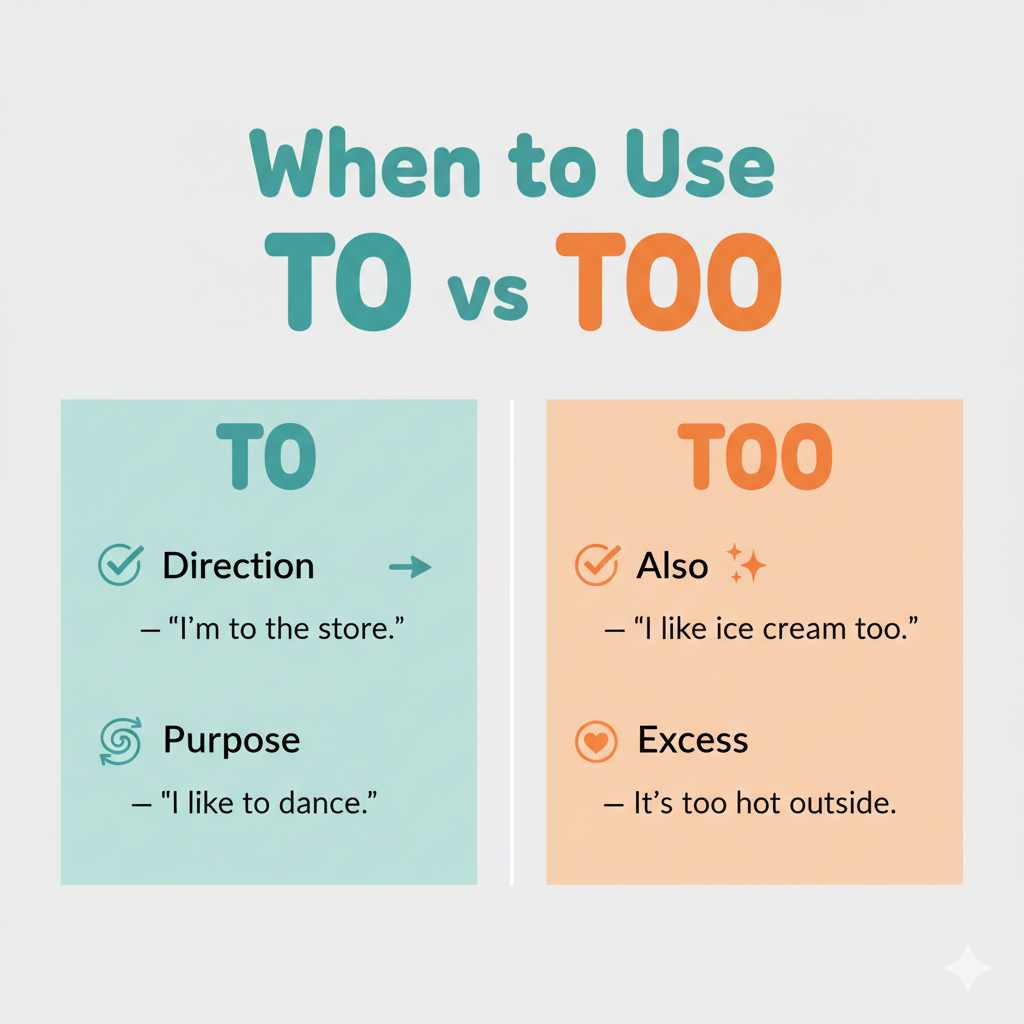To Vs. Too: What’s the Difference and When to Use Each
"To" and "too" are commonly confused words. Discover their differences, usage rules, and examples to avoid common mistakes.
English is a broad language with millions of rhyming words that sound similar but have different meanings.
It is stated from an educational survey that around 20-25% of common grammatical mistakes involve homophones, with “to” and “too” among the most misused.
These types of mistakes are easily detectable and make your document grammatically incorrect.
For example, words like “wind” and “wind” look alike. In this pair, one “wind” refers to air in motion, while the other is the past tense of the verb “wind,” used to describe wrapping something.
These types of words are known as homophones and often create confusion about which word to use.
But once you understand the minor differences between them, you’ll know how to use them appropriately.
To put it simply, I’ve brought together information on each word “to” and “too” specifically to explain:
- The difference between “to” and “too”
- When to use “to”
- When to use “too”
- Relevant examples of using “to” and “too” in a sentence
So, let’s get started!
To Vs. Too: what’s the difference?
“To” and “too” are two words that are pronounced the same way. However, how they vary in different types of sentences according to their meaning.
For example, “to” is typically used to indicate a direction or purpose, as in:
“I am going to the market.“ In this sentence, “the market” is the destination, and “to” helps convey the direction.
On the other hand, “too” means “also” or “very,” depending on the context.
For example: “I like pizza too,” or in another scenario, “It is too smoggy outside.”
A minor difference can change the whole meaning of a sentence.
If you find difficulty to understand the complete meaning of this information, you can get help form an AI summarizer and it will help you to understand the crux of the information.
Furthermore, these below mentioned examples will also gives a little bit clarity of the major difference between the “to” and “too” words:
- “To” is used to show direction or purpose, such as: “I am going to the store.”
- “Too” means “also” or “very,” such as: “I like ice cream too” and “It is too hot outside.”
When to use “to”
Every word has a specific place in a sentence to make it more meaningful and easy to understand.
For example, the word “to” is a preposition with multiple uses.
As a preposition, it shows direction or movement toward an objective, such as in, “I'm going to the restaurant.”
As an infinitive marker, “to” is placed before a verb to form the infinitive, as in, “I want to eat.”
Some common sentence structuring rules for using “to” in a sentence are:
1. Verb + to + Verb (Infinitive)
- I like to dance.
- She wants to learn Dutch.
2. Preposition + to + Noun/Pronoun
- I went to the hospital.
- He gave the water bottle to me.
3. Adjective + to + Noun/Pronoun
- It's important to be loyal.
- It's difficult to write.
When to use word “Too”
“Too” is also an English word, but it is not a preposition.
It doesn’t have a meaning on its own, but when combined with an adjective or adverb, it becomes meaningful.
For example, to add support to someone’s statement, the word “too” is commonly used.
It also provides more clarity to verbs, adverbs, adjectives, and phrases.
A few grammatical rules for using the word “too” in a sentence are:
1. Too + Adjective/Adverb
- The soup is too hot.
- She runs too slow.
2. Subject + Verb + Too
- I like pizza too.
- He went to the hospital too.
Relevant examples of using “to” and “too” in a sentence
Once you are completely aware of using various “enquiry or inquiry”, you can also get assistance from AI tools.
For better results, saving time, and avoiding manual effort, simply enter your main keyword into an AI paragraph writer tool, set a creative or casual tone, and click to generate humanized AI text.
It will automatically provide text, adjusting the appropriate use of these similarly pronounced words.
Additionally, here are some more examples of using these words:
Examples with the use of word “to”
- I’m going to the grocery store to pick up some fresh vegetables.
- He plans to study computer science in college next year.
- She gave the book to her friend as a birthday present.
- We decided to go on a road trip during the holiday season.
- Don’t forget to call your mom when you get home.
Examples with the use of word “too”
- I’d love to come to the concert, but it’s too expensive for my budget.
- The soup is too hot to eat right now, let’s wait a bit.
- She feels too tired to go to the gym after a long day at work.
- There are too many people at the event; it’s hard to find a seat.
- I ordered pizza, and my friend got one, too.
What you understand about the difference of “to” and “too”
Finally, after reading this guide, you will have clear information on how to use the words “to” and “too” more effectively.
Both of these words sound similar but are used for different purposes.
In English grammar, there are many words that have the same pronunciation but different meanings.
A reliable paragraph checker can help you spot and correct these tricky word pairs in your writing.
So, if you ever find it difficult to understand when to use each word, this guide will be very helpful.

